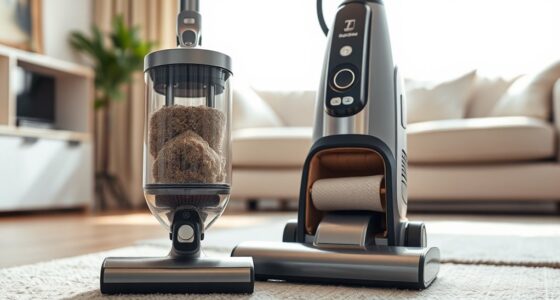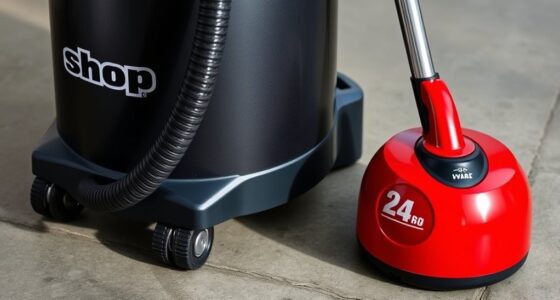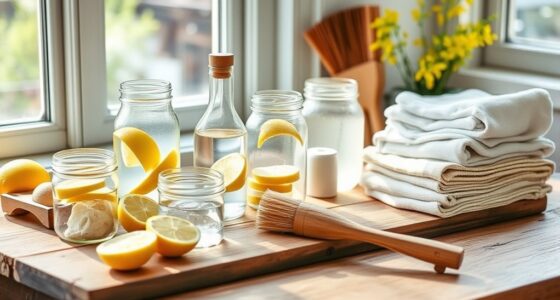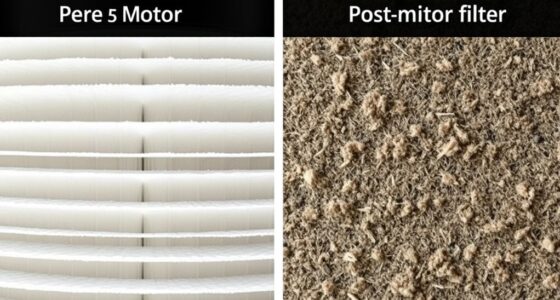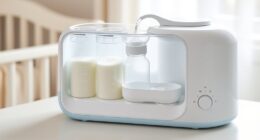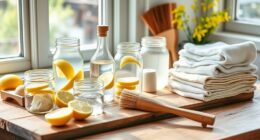When choosing household cleaners, you should avoid products with toxic chemicals like ammonia, chlorine bleach, phosphates, and synthetic fragrances. These ingredients can cause respiratory issues, eye and skin irritation, and environmental harm. Many also linger in your home and water supply, posing long-term health risks. To keep your space safe, opt for natural alternatives and carefully check labels. If you want to discover more about what ingredients to watch for, stay with us.
Key Takeaways
- Ammonia and chlorine bleach can cause respiratory irritation and long-term health issues.
- Phosphates contribute to water pollution and harmful algal blooms.
- Synthetic fragrances and preservatives may act as allergens and endocrine disruptors.
- Many toxic chemicals linger indoors, increasing exposure and health risks.
- Choosing natural alternatives and reading labels reduce environmental and health hazards.
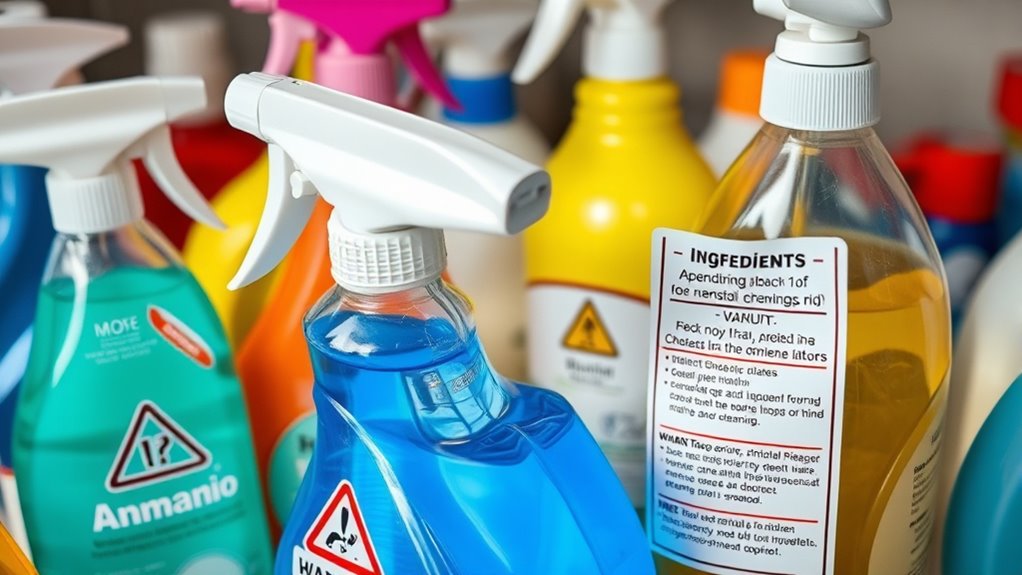
Many ingredients commonly found in processed foods can harm your health, so it’s important to know which ones to avoid. This idea extends beyond what you eat and into the household products you use daily. When it comes to household cleaners, many contain toxic chemicals that pose significant health risks and also have a troubling environmental impact. These chemicals can linger in your home, potentially causing respiratory issues, skin irritation, or even more serious long-term health problems. Understanding what to steer clear of helps you create a safer environment for yourself and your loved ones.
One of the most common harmful chemicals in household cleaners is ammonia. While effective at cutting through grease and grime, ammonia can cause respiratory irritation, especially if used in poorly ventilated spaces. Breathing in its fumes repeatedly can lead to chronic respiratory issues over time. Beyond health risks, ammonia contributes to environmental pollution when it’s washed down the drain, contaminating water sources and harming aquatic life. It’s a prime example of how a seemingly harmless cleaning agent can have broader ecological consequences.
Similarly, products containing chlorine bleach are widespread, but they come with notable health risks. Chlorine releases toxic fumes that can cause eye, throat, and lung irritation, particularly if you’re not careful during use. Long-term exposure has been linked to respiratory problems and, in some cases, more serious conditions. From an environmental standpoint, chlorine bleach contributes to water pollution and can generate harmful byproducts when it reacts with organic matter in water systems. These byproducts can be toxic to aquatic organisms and disrupt ecosystems.
Many household cleaners also contain phosphates, which may seem like a minor additive but have a significant environmental impact. Phosphates are known to cause algal blooms in water bodies, depleting oxygen and killing aquatic life. They also pose health risks if residues remain in your home, especially for children who might ingest contaminated dust or surfaces. Manufacturers often add these chemicals because they’re cheap and effective, but their long-term ecological footprint is considerable.
Finally, synthetic fragrances and preservatives in cleaning products aren’t just potential allergens—they can also act as endocrine disruptors, affecting hormone function over time. These compounds often escape into the air or settle on surfaces, contributing to indoor pollution. From an environmental perspective, these chemicals can persist in ecosystems, accumulating in wildlife and water sources, further damaging the planet. By choosing natural alternatives and reading labels carefully, you minimize your exposure to these harmful ingredients and reduce your environmental impact. Being aware of these chemicals allows you to make smarter choices, protecting your health and the environment simultaneously.
Frequently Asked Questions
Are Natural Cleaning Products Completely Safe to Use?
Natural alternatives are generally safer, but they aren’t always completely safe to use. You should read chemical disclosures carefully, as some natural ingredients can still cause allergies or irritation. While they tend to contain fewer toxic chemicals, it’s important to use them as directed and test on small areas first. Always stay informed about ingredients, and remember that “natural” doesn’t automatically mean “risk-free.”
How Can I Identify Hidden Toxic Chemicals on Labels?
Did you know that over 60% of cleaning products contain undisclosed chemicals? To spot hidden toxins, focus on chemical ingredient transparency and use label reading strategies. Always check for unfamiliar or unlisted ingredients, and look for certifications like EPA Safer Choice. Avoid vague terms like “fragrance” or “protective agents,” and research unfamiliar ingredients online. Staying vigilant helps you identify and steer clear of hidden toxic chemicals on labels effectively.
Do All Brands List All Chemicals Used in Their Products?
Not all brands fully list every chemical on their labels due to varying labeling regulations. You can’t always rely on ingredient transparency, so it’s smart to research brands known for clear labeling policies. Look for products that voluntarily disclose all ingredients and avoid vague terms like “fragrance” or “surfactants.” Staying informed helps you choose safer household cleaners and minimizes exposure to potentially toxic chemicals.
What Are the Long-Term Health Effects of Exposure to These Chemicals?
Think of your body as a sponge slowly absorbing chemicals over time. Long-term exposure to toxic chemicals in household cleaners can lead to chronic health risks like respiratory issues, hormonal disruptions, and even cancer. Chemical accumulation builds silently, often causing damage before symptoms appear. You might not notice the harm right away, but over years, these chemicals can impact your health profoundly, making it essential to choose safer cleaning options.
Are There Any Regulations Governing the Safety of Household Cleaners?
Regulatory standards do govern household cleaners, but they vary by country. Agencies like the EPA or FDA set safety guidelines, but enforcement can be inconsistent. You should check for chemical disclosures on labels or safety data sheets to understand what’s inside. While regulations aim to protect consumers, staying informed and choosing products with transparent ingredient lists helps you avoid harmful chemicals and guarantee your household’s safety.
Conclusion
Now that you know which toxic chemicals lurk in household cleaners, it’s time to take action. Read labels carefully, opt for natural alternatives, and don’t be fooled by fancy marketing tricks. Protect your family’s health and the environment—think of it as your personal quest, much like a knight of old. By making informed choices today, you’re forging a safer, cleaner home. Remember, a little vigilance goes a long way in keeping your castle safe.

